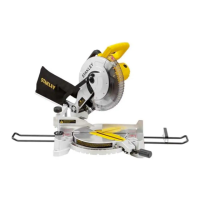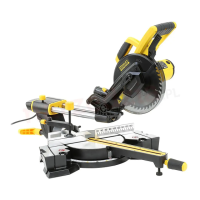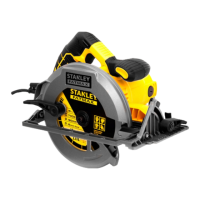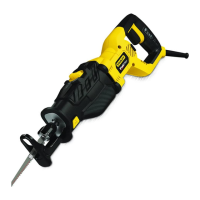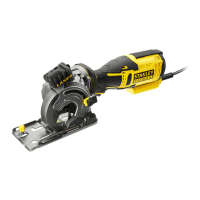11
NOTE: Never engage the blade lock while saw is running,
or engage in an effort to stop the tool. Never turn the saw
on while the blade lock is engaged. Serious damage to
your saw will result.
TO REPLACE THE BLADE (FIG. B–D,)
1. To loosen the blade clamping screw (j), depress the blade
lock (c) and turn the saw spindle with the blade wrench (s)
until the blade lock engages and the blade stops rotating.
With the blade lock engaged, turn the blade clamping
screw counterclockwise with the blade wrench (screw has
right-hand threads and must be turned counterclockwise to
loosen).
2. Remove the blade clamping screw (j) and outer clamp
washer (n). Remove old blade.
3. Clean any saw dust that may have accumulated in the
guard or clamp washer area and check the condition and
operation of the lower blade guard as previously outlined.
Do not lubricate this area.
4. Always use blades that are the correct size (diameter)
with the proper size and shape center hole for mounting
on the saw spindle. Always assure that the maximum
recommended speed (rpm) on the saw blade meets or
exceeds the speed (rpm) of the saw.
5. Follow steps 1 through 5 under To Install the Blade,
making sure that the blade will rotate in the proper direction.
LOWER BLADE GUARD
WARNING: The lower blade guard is a safety
feature which reduces the risk of serious personal
injury. Never use the saw if the lower guard is
missing, damaged, misassembled or not working
properly. Do not rely on the lower blade guard to protect you
under all circumstances. Your safety depends on following
all warnings and precautions as well as proper operation of
the saw. Check lower guard for proper closing before each
use. If the lower blade guard is missing or not working
properly, have the saw serviced before using. To assure
product safety and reliability, repair, maintenance and
adjustment should be performed by an authorized service
center or other qualified service organization, always using
identical replacement parts.
WARNING: Never use the saw whose lower guad
kept opening by adding a wedge, string, rubber
band, or other materials.USE
CHECKING THE LOWER GUARD(FIG.A)
1. Turn tool off and disconnect from power supply.
2. Rotate the lower guard lever (k) from the fully closed
position to the fully open position.
3. Release the lever and observe the lower guard (i) return
to the fully closed position.
The tool should be serviced by a qualified service center if it:
♦ fails to return to the fully closed position,
♦ moves intermittently or slowly, or
♦ contacts the blade or any part of the tool in all angles
and depth of cut.
BLADES
WARNING: To minimize the risk of eye injury,
always use eye protection. Carbide is a hard but
brittle material. Foreign objects in the workpiece
such as wire or nails can cause tips to crack or
break. Only operate saw when proper saw blade guard is
in place. Mount blade securely in proper rotation before
using, and always use clean, sharp blade.
If you need assistance regarding blades, please contact
your local STANLEY dealer.
Depth of Cut Adjustment (FIG. E–G)
1. Raise the depth adjustment lever (p) to loosen.
2. To obtain the correct depth of cut, align the notch (q) on
the depth adjustment strap with the appropriate mark on the
upper blade guard (l).
3. Tighten the depth adjustment lever
4. For the most efficient cutting action using a carbide
tipped saw blade, set the depth adjustment so that about
one half of a tooth projects below the surface of the wood
to be cut.
5. A method of checking for the correct cutting depth is
shown in Figure G. Lay a piece of the material you plan to
cut along the side of the blade, and observe how much tooth
projects beyond the material.
Bevel Angle Adjustment (FIG. H)
The bevel angle adjustment mechanism (g) can be adjusted
between 0° and 45°.
1. Turn the bevel adjustment knob (f) to loosen.
2. Tilt the foot plate to the desired angle mark on the pivot
bracket (u).
3. Turn the bevel adjustment knob to retighten.
Kerf Indicator (FIG. I)
The front of the saw shoe has a kerf indicator (t) for vertical
and bevel cutting. This indicator enables you to guide the saw
along cutting lines penciled on the material being cut. The
indicator lines up with the left (inner) side of the saw blade,
which makes the slot or “kerf” cut by the moving blade fall
to the right of the indicator. The notches on the base plate
indicate 0˚ and 45˚.
Mounting and Adjusting the Parallel Fence (FIG. J)
The parallel fence (w) is used for cutting parallel to the edge
of the workpiece.
MOUNTING
(FIG.J-K)
1. Insert parallel fence adjustment knob (x) into the hole
(aa) as shown in Figure J, keeping the knob loose to allow
the parallel fence to pass.
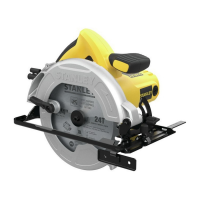
